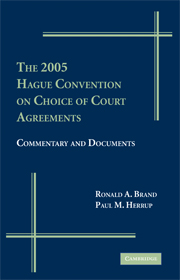Book contents
- Frontmatter
- Contents
- Preface
- PART I A BASIC INTRODUCTION TO THE 2005 HAGUE CHOICE OF COURT CONVENTION
- PART II ARTICLE-BY-ARTICLE COMMENTARY ON THE CONVENTION
- 4 Scope and Definitions (Articles 1–4)
- 5 Jurisdiction (Articles 5–7)
- 6 Recognition and Enforcement (Articles 8–15)
- 7 General Clauses (Articles 16–26)
- 8 Final Clauses (Articles 27–34)
- PART III CHOICE OF COURT IN THE ABSENCE OF A MULTILATERAL CONVENTION
- PART IV LITIGATION AND ARBITRATION CHOICES AFTER THE HAGUE CONVENTION
- Appendix A Explanatory Report by Trevor Hartley & Masato Dogauchi (including the text of the 2005 Hague Convention on Choice of Court Agreements)
- Appendix B Cited Excerpts from the Nygh-Pocar Report
- Index
4 - Scope and Definitions (Articles 1–4)
from PART II - ARTICLE-BY-ARTICLE COMMENTARY ON THE CONVENTION
Published online by Cambridge University Press: 26 October 2009
- Frontmatter
- Contents
- Preface
- PART I A BASIC INTRODUCTION TO THE 2005 HAGUE CHOICE OF COURT CONVENTION
- PART II ARTICLE-BY-ARTICLE COMMENTARY ON THE CONVENTION
- 4 Scope and Definitions (Articles 1–4)
- 5 Jurisdiction (Articles 5–7)
- 6 Recognition and Enforcement (Articles 8–15)
- 7 General Clauses (Articles 16–26)
- 8 Final Clauses (Articles 27–34)
- PART III CHOICE OF COURT IN THE ABSENCE OF A MULTILATERAL CONVENTION
- PART IV LITIGATION AND ARBITRATION CHOICES AFTER THE HAGUE CONVENTION
- Appendix A Explanatory Report by Trevor Hartley & Masato Dogauchi (including the text of the 2005 Hague Convention on Choice of Court Agreements)
- Appendix B Cited Excerpts from the Nygh-Pocar Report
- Index
Summary
GENERAL MATTERS
Chapter I of the Convention is titled “Scope and Definitions” and provides critical Convention building blocks. Articles 1 and 2 set out the substantive scope of application of the Convention, while Articles 3 and 4 provide definitions and discussion of certain key terms. The Convention begins in Article 1(1) with an extremely broad scope of application. This is a threshold policy choice, which is reflected in a number of provisions of the text. Article 2 then proceeds to exclude specific types of contracts and specific “matters” from scope, and to provide further clarifications and amplifications in this area.
A sequential review of the Articles in Chapter I does not necessarily provide the best understanding of its rules. Thus, the following discussion will consider those Articles by concept rather than by numerical order. Article 1 forms a logical unit with the supporting definitions in Articles 3 and 4. Article 2 then qualifies the operation of that system, in ways generally independent of the definitions in Articles 3 and 4. This order of presentation underscores a basic characteristic of the Convention text: it is a highly coordinated and interconnected web. Very few articles can be discussed in isolation.
- Type
- Chapter
- Information
- The 2005 Hague Convention on Choice of Court AgreementsCommentary and Documents, pp. 39 - 77Publisher: Cambridge University PressPrint publication year: 2008



